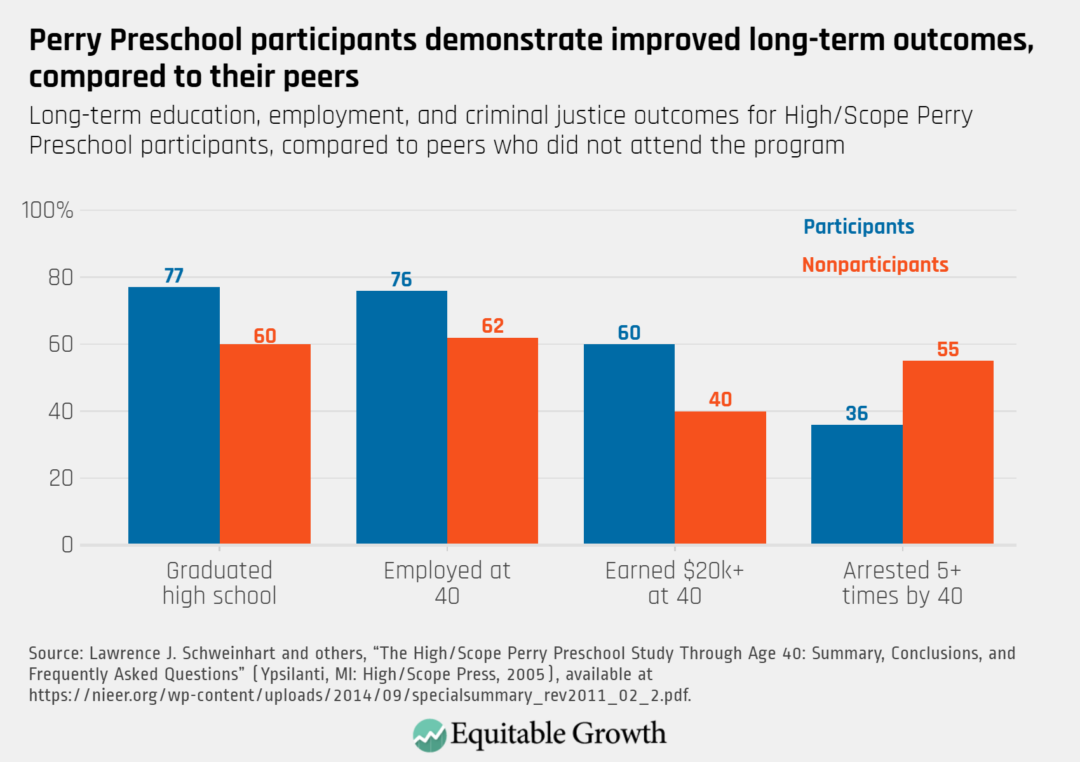Factsheet: What the research says about the economics of early care and education

Despite the important role that child care plays in the lives of many U.S. families, the private child care market is not meeting their needs. This is not just an issue for families with young children in the United States—accessible, affordable, and high-quality care also has the potential to generate substantial economic activity and growth that benefits the entire economy.1
Public investments in child care can help eliminate the drag on growth that the lack of child care options creates. These investments, in turn, facilitate economic gains for families, businesses, and the U.S. economy as a whole.
This factsheet will review the research on the short- and long-term economic growth potential of a high-quality, accessible, and affordable early care and education system as well as the evidence supporting greater public investment in this market. For more information, see Equitable Growth’s companion report on the child care economy.
The current child care market doesn’t meet U.S. families’ needs
- Licensed child care is hard to find. Roughly half of U.S. families live in “child care deserts,” or U.S. Census Bureau tracts where there are three young children for every licensed child care slot.2
- In recent years, it has gotten even harder to find licensed child care options. Overall, the number of licensed child care facilities shrunk by nearly 32 percent in recent decades, primarily due to small in-home providers exiting the market. From 2005 through 2017, nearly half of these providers left the market.3 The coronavirus pandemic has only worsened these supply challenges.
- When families can find child care, it is often unaffordable. In 2019, the average annual price of center-based care was more than $11,000 for infants and more than $9,000 for 4-year-olds.4 In 28 states, the annual price of full-time child care can exceed that of in-state college tuition.5
- Insufficient child care options can prevent parents who wish to work from doing so, with mothers often bearing the brunt of this challenge. Among parents who wish to work, child-rearing tends to interfere with women’s labor supply and employment outcomes more than men’s. 6 This leaves potential economic growth unrealized, as women’s labor force participation is significantly associated with Gross Domestic Product growth.7
Accessible and affordable early care and education options can help parents who wish to work do so, promoting economic growth in the short term
- When more child care options are available, labor force participation increases. A 2007 study using data from Maryland finds that when there are more child care options nearby, women’s labor supply increases. For every 100 additional child care slots, the women’s labor force participation rate goes up by 0.3 percentage points.8
- When the price of child care decreases, maternal employment increases. Studies generally find that a 10 percent reduction in child care costs increases maternal employment between 0.25 percent and 11 percent, with more precise estimates suggesting a 0.5 percent to 2.5 percent increase.9 This leads to greater household economic security and higher consumer spending, a larger labor pool from which employers can find workers, and, ultimately, short- and long-term economic growth.
- Dependable and affordable child care options keep parents in the workforce, which benefits employers who count on dependable workers. A 2008 study of mothers in low-wage jobs found that 19 percent stopped working entirely in the same quarter in which they experienced a disruption to their child care arrangements, compared to only 9 percent who did not experience such a disruption.10
High-quality early care and education promotes long-term economic growth because the workers of tomorrow develop their skills early
- High-quality early care and education provides critical socialization and learning opportunities when the brain is developing rapidly and is particularly responsive to the outside environment.11 Young children in pre-Kindergarten programs experience positive developmental outcomes and are better prepared for school, scoring higher than their peers on standardized measures of reading, spelling, math, and problem-solving skills.12
- The positive human capital development effects persist long past childhood.13 One study shows that 40-year-olds who participated in the High/Scope Perry Preschool program as children were significantly more likely to be employed, uninvolved with the criminal justice system, and become high school graduates and high earners than their peers who did not complete the program.14 (See Figure 1.)
Figure 1

- Similarly, enrollment in Boston’s universal preschools increases the likelihood of high school graduation by 6 percentage points, SAT completion by 9 percentage points, and on-time college enrollment by 8 percentage points, as well as decreases the likelihood of juvenile justice system involvement and school suspensions by 1 percentage point and 2 percentage points, respectively.15
Greater public investment is needed to unlock the full economic potential of high-quality early care and education
- Child care subsidies can increase employment among mothers. In one 2020 study, a 10 percent increase in child care subsidies was associated with a 2 percent increase in employment among married mothers. Prior research also indicates that a $100 increase in child care subsidies could increase employment among single mothers by 2 percentage points.16
- Unfortunately, access to these subsidies remains limited. A recent Government Accountability Office report estimates that only 14 percent of qualifying children receive any subsidies.
- Adequate funding is necessary for human capital development. Subsidy dollar amounts are generally low and primarily cover staffing costs, leaving insufficient funds to invest meaningfully in the activities and materials that promote quality care and education for young children.17 Fully funding the subsidy programs and devoting resources for state-level agencies to assist providers in qualifying for subsidies are two ways in which greater public investment could increase child care availability and quality.
- Supporting child care workers is crucial for promoting quality care and human capital development. Child care workers have a median hourly wage of $12.88, or $26,970 per year.18 Low pay leads to high turnover and high stress in the profession, which can undermine the quality of care that children receive. Using public funds to support higher compensation would help stabilize the child care workforce, ensuring that these workers can afford to stay in their jobs.19
- Investing in the nation’s children is one of the safest bets policymakers can make. Research on early care and education programs finds that $1 in spending generates $8.60 in economic activity. The work of Nobel Prize-winning macroeconomist Paul Romer and others suggests that spending on human capital is one of the most effective ways to use government dollars to strengthen the economy and should be a priority for policymakers who seek to spur economic growth.20
By neglecting the child care market for decades, policymakers have shifted the burden of child care onto the shoulders of U.S. families already bearing the weight of childrearing, employment, and other responsibilities at home—despite research showing that the U.S. economy has much to gain from a functional and equitable child care system.
Addressing the child care crisis has the potential to improve families’ economic security and well-being in the United States, all while accelerating economic growth in the short- and long-term. To do so, policymakers must unburden families with meaningful, targeted, and evidence-based investments in the nation’s early care and education system.
For more information, see Equitable Growth’s report on the child care economy.
End Notes
1. Ajay Chaundry and others, Cradle to Kindergarten: A New Plan to Combat Inequality, 2nd ed. (New York: The Russell Sage Foundation, 2021), pp. 41–69.
2. Rasheed Malik and others, “America’s Child Care Deserts in 2018” (Washington: Center for American Progress, 2018), available at https://www.americanprogress.org/issues/early-childhood/reports/2018/12/06/461643/americas-child-care-deserts-2018//.
3. Office of Child Care, “The Decreasing Number of Child Care Providers in the United States” (Washington: U.S. Department of Health and Human Services, 2019), available at https://www.acf.hhs.gov/occ/news/the-decreasing-number-of-family-child-care-providers-in-the-united-states.
4. Child Care Aware of America, “The US and the High Price of Child Care: An Examination of a Broken System” (2019), available at https://www.childcareaware.org/our-issues/research/the-us-and-the-high-price-of-child-care-2019/.
5. Economic Policy Institute, “The Cost of Child Care in the United States” (2020), available at https://www.epi.org/child-care-costs-in-the-united-states/.
6. Sara Raley, Suzanne M. Bianchi, and Wendy Wang, “When Do Fathers Care? Mothers’ Economic Contributions and Fathers’ Involvement in Child Care,” American Journal of Sociology 117 (5) (2012), available at https://www.journals.uchicago.edu/doi/10.1086/663354.
7. Ozlem Tasseven, “The relationship between economic development and female labor force participation rate: A panel data analysis.” In Ü. Hacioğlu and H. Dinçer, eds., Global Financial Crisis and Its Ramifications on Capital Markets (Basel, Switzerland: Springer, Cham, 2017), available at https://doi.org/10.1007/978-3-319-47021-4_38.
8. Chris M. Herbst and Burt S. Barnow, “Close to Home: A Simultaneous Equations Model of the Relationship Between Child Care Accessibility and Female Labor Force Participation,” Journal of Family and Economic Issues 29 (2008): 128–151, available at https://doi.org/10.1007/s10834-007-9092-5.
9. Taryn Morrissey, “Child Care and Parent Labor Force Participation: A Review of the Research Literature,” Review of Economics of the Household 15 (1) (2017): 1–24, available at https://link.springer.com/article/10.1007%2Fs11150-016-9331-3; Taryn Morrissey, “Addressing the need for affordable, high-quality early childhood care and education for all in the United States” (Washington: Washington Center for Equitable Growth, 2019), available at https://equitablegrowth.org/addressing-the-need-for-affordable-high-quality-early-childhood-care-and-education-for-all-in-the-united-states/.
10. Rachel A. Gordon, Robert Kaestnery, and Sanders Korenman, “Child Care and Work Absences: Trade-Offs by Type of Care,” Journal of Family and Marriage 70 (1) (2008), available at https://www.jstor.org/stable/40056266?seq=1.
11. Neal Halfon, Ericka Shulman, and Miles Hochstein, “Brain Development in Early Childhood. Building Community Systems for Young Children” (Los Angeles: University of California Center for Healthier Children, Families, and Community, 2001), available at https://files.eric.ed.gov/fulltext/ED467320.pdf.
12. William T. Gormley, Jr. and others, “The Effects of Universal Pre-K on Cognitive Development,” Developmental Psychology 41 (6) (2005), available at https://www.apa.org/pubs/journals/releases/dev-416872.pdf.
13. Taryn Morrissey, Lindsey Hutchinson, and Kimberly Burgess, “The Short- and Long-Term Impacts of Large Public Early Care and Education Programs” (Washington: U.S. Department of Health and Human Services, 2014), available at https://aspe.hhs.gov/system/files/pdf/180301/rb_longTermImpact.pdf.
14. Lawrence J. Schweinhart and others, “The High/Scope Perry Preschool Study Through Age 40: Summary, Conclusions, and Frequently Asked Questions” (Ypsilanti, MI: High/Scope Press, 2005), available at https://nieer.org/wp-content/uploads/2014/09/specialsummary_rev2011_02_2.pdf.
15. Guthrie Gray-Lobe, Parag A. Pathak, and Christopher R. Walters, “The Long-Term Effects of Universal Preschool in Boston.” Working Paper 28756 (National Bureau of Economic Research, 2021), available at http://www.nber.org/papers/w28756.
16. Gabrielle Pepin, “The Effects of Child Care Subsidies on Paid Child Care Participation and Labor market Outcomes: Evidence from the Child and Development Care Credit.” Working Paper 20-331(W.E. Upjohn Institute for Employment Research, 2020), available at https://research.upjohn.org/cgi/viewcontent.cgi?article=1350&context=up_workingpapers; Chris M. Herbst, “The labor supply effects of child care costs and wages in the presence of subsidies and the earned income tax credit,” Review of Household Economics 8 (2) (2009), available at https://link.springer.com/article/10.1007%2Fs11150-009-9078-1.
17. Marsha Weinraub and others, “Subsidizing child care: How child care subsidies affect the child care used by low-income African Americans families,” Early Childhood Research Quarterly 20 (2005), available at https://citeseerx.ist.psu.edu/viewdoc/download?doi=10.1.1.565.2163&rep=rep1&type=pdf; Suzanne W. Helburn, John R. Morris, and Kathy Modigliani, “Family child care finances and their effect on quality and incentives,” Early Childhood Research Quarterly 17 (4) (2002), available at https://www.sciencedirect.com/science/article/abs/pii/S0885200602001886?via%3Dihub.
18. U.S. Bureau of Labor Statistics, “Occupational Employment and Wages, May 2020, 39-9011 Childcare Workers” (Washington: U.S. Department of Labor, 2021), available at https://www.bls.gov/oes/current/oes399011.htm.
19. Eric C. Twombly, Maria D. Montilla, and Carol J. De Vita, “State Initiatives to Increase Compensation for Child Care Workers” (Washington: Urban Institute, 2001), available at https://files.eric.ed.gov/fulltext/ED452993.pdf.
20. Bassam A. Albassam and Mariam Camarero, “A model for assessing the efficacy of government expenditure,” Cogent Economics & Finance 8 (1) (2020), available at https://www.tandfonline.com/doi/full/10.1080/23322039.2020.1823065; Paul M. Romer, “Human Capital and Growth: Theory and Evidence,” Carnegie-Rochester Conference Series on Public Policy 32 (1990), available at https://www.sciencedirect.com/science/article/abs/pii/016722319090028J?via%3Dihub.







